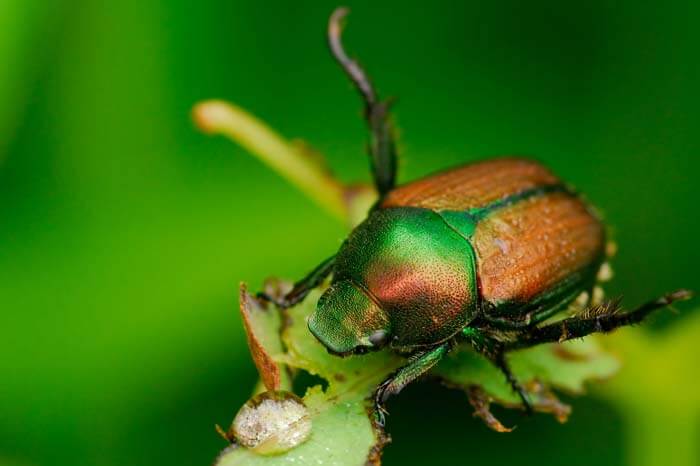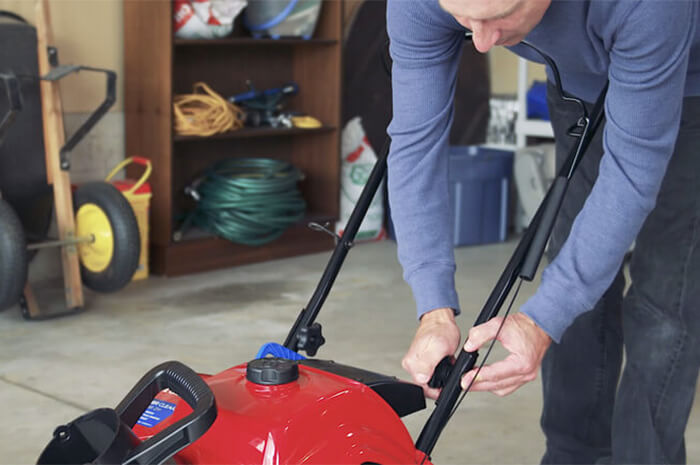
Keeping your yard healthy isn’t just a matter of watering and mowing, it also means preventing or removing pests as necessary. To help keep your lawn in top shape—and maybe learn what those bugs flying around in your yard are—take a look at our guide covering some of the most common yard and underground pests.
Underground Pests
- White Grubs
- Billbugs
- Mole Crickets
Lawn Pests
- Chinch Bugs
- Sod Webworms
- Fall Armyworms
- Leafhoppers
- Green Aphids
Underground Pests
These pests often kill grass by eating roots and disturbing root zones, so they can be harder to spot than aboveground bugs. Take a look below to learn the signs and management techniques for some of the most common underground pests you’ll find in your yard.
White Grubs
These grass root-eating pests are larvae of the scarab beetle family include Japanese beetles, June bugs, rose chafers, and the black turfgrass ataenius. Grub size and characteristics vary, but grubs are generally plump, whitish gray and C-shaped with brown heads, and three pairs of legs. In the summer, you can identify adult Japanese beetles, metallic green with copper wings, and June bugs, reddish brown nocturnal fliers.
Look for:
Wilted, bluish-gray grass that appears as drought damage in late spring then becomes dried and browned-out turf later in the season. With the roots eaten, the turf will roll back when pulled on. Once soil heats up to 60° Fahrenheit in spring, you will find grubs in the top few inches of dirt. Unless the grass is already in poor condition, control is usually not necessary until you have 10- to 15-grubs per square foot.
Management:
Before using milky spore disease to combat Japanese beetle grubs, check with your Cooperative Extension Service (CSREES) to see if the spore is effective in your area. Studies indicate that milky spore, especially in colder climates, is less effective than previously thought. Because the beetles prefer moist soil for laying eggs, one tactic is to water deeply, but infrequently, during the summer. White grubs are also susceptible to parasitic nematodes such as Steinernema carpocapsae. If damage warrants reseeding, turning over the soil and either hand picking out the grubs or leaving them exposed for birds may serve as a short-term alternative. A lawn attacked by grubs will have patches of dead, dying or wilted grass. However, if injury is moderate, the lawn may recover.
Billbugs
The C-shaped, small white larvae of this weevil causes more damage than the adult does. Found more commonly in northern states, billbugs prefer Kentucky bluegrass, feeding on stems, crowns and eventually roots.
Look for:
Irregular dry patches the color of whitish straw that develop by midsummer. When you tug affected grass, it breaks off at the root line, exposing hollowed-out stems packed with sawdust-like material. Unlike grub damage, the turf will not feel spongy. You may note some of the legless larvae underground.
Management:
Nematodes are showing promise for this difficult-to-control bug. Try using insect-resistant bluegrass varieties (i.e. Park, Arista, NuDwarf, and Delta), or endophyte-enhanced ryegrass and fescues. For spot treatment, use Rotenone, a botanical insecticide.
Mole Crickets
These large crickets with short, stout forelegs feed on grass roots and tunnel through underground root zones. Especially damaging yard pests in the light, sandy soils of the southern and Gulf plains, they prefer bahiagrass, but feed on whatever grass is available.
Look for:
Small tunnel openings and spongy earth along with browned, dry patches of turf. Use a soap drench and observe for three minutes. Finding two to four crickets per 4-square feet is significant.
Management:
Follow practices to encourage deep roots and to keep thatch low. Use low-nitrogen fertilizer to avoid developing overly succulent growth, and mow high. Research done at the University of Florida has shown promising results using a parasitic nematode, Steinernema scaperisci. In addition, ground beetles are a beneficial predator of mole crickets.
Lawn Bugs
Lawn pests are usually easier to spot than their underground counterparts, but can pose a number of different challenges when trying to remove and prevent them from damaging your grass. If you’re having trouble with unknown pests in your yard, take a look at this list for help identifying and managing them.
Chinch Bugs
Chinch bugs are the premier pest on St. Augustinegrass lawns yards and will attack other grasses except those in the coldest climates. Black, winged, and 1/5-inch long, they live and lay eggs in the thatch layer at the root line. Most damaging are the tiny red nymphs, which thrive on sap sucked from grass stems while the adult chinch bug is the scourge of southern grasses.
Look for:
Starting in June on hot, dry, sunny lawns, look for yellow patches that do not improve with watering. Look under the grass canopy to see nymphs and adults. An alternative is to use the water flotation test. If you see 20 to 25 bugs over five minutes, you need to take action.
Management:
Maintain minimum fertilization, irrigate regularly, keep thatch low and raise mowing height. Encourage beneficial big-eyed bugs, and use endophyte-enhanced, resistant grass cultivars. For St. Augustinegrass, floralawn and floratam are resistant varieties, however, floratine is tolerant to chinch bugs. If cultivars do not cure the problem, consider spot treatment with insecticidal soap or pyrethrin.
Sod Webworms
You might not notice these nighttime feeders until the damage is obvious. These small, green, spotted caterpillars feed on grass roots, crowns, and leaves. The adult form, a small, whitish gray to brown moth, flies in the evening.
Look for:
Irregular brown patches of short or uneven turf in early spring, especially in hot, dry areas. On close inspection, you may see silken grass tunnels used for daytime shelter and green waste pellets in the thatch. To check the population level, use a soap drench over affected areas; 15 webworms per square yard require action.
Management:
An extra dose of fertilizer in the spring and increased irrigation can repair the damage. Minimize thatch and encourage ground beetles. Bacillus thuringiensis (BT) is effective on young larvae, and Steinernema nematodes are a useful biological control. Endophyte-enhanced perennial ryegrasses, Tall fescues and Fine fescues will help thwart hungry webworms.
Fall Armyworms
At 1-1/2 to 2-inches, these striped, brownish-green nighttime feeders are twice as long as webworms. A southern insect, they will move north, either as spring-migrating moths or as caterpillar armies, seeking food in summer and fall. Parasitic nematodes will help keep it in check.
Look for:
Chewed, bare, circular areas, similar to the damage of webworms, except that armyworms do not make tunnels. With large infestations, damage can accumulate quickly.
Management:
Use of Bacillus thuringiensis BT spray, some botanical insecticides (such as natural pyrethrum), and parasitic nematodes (such as Steinernema carpocapsae) will help. Encourage predators such as braconid wasps, ground beetles and birds. Maintain optimal conditions to encourage new growth.
Leafhoppers
These tiny, wedge-shaped, green, yellow or brown flying bugs suck sap from leaves while injecting toxins into the grass. Lawn damage is usually slight. You can keep leafhopper populations in check with ladybugs and other beneficial insects.
Look for:
Mottled whitish patches with leaves browned along the edge and curled at the tips. Young leafhoppers will hop away, and adults fly away, if disturbed.
Management:
Maintain lawn vigor through regular cultural practices. Encourage lacewings and ladybugs. Use insecticidal soap or botanical insecticides for severe infestations.
Green Aphids
These tiny pear-shaped insects (sometimes called greenbugs) feed on the juices of grass blades while injecting a salivary toxin. They have been causing serious damage to Kentucky bluegrass lawns in some Midwestern states since the mid-1970s.
Look for:
Yellowing of turf, frequently in sunny locations but sometimes extending out from the base of shade tree trunks. Close inspection will reveal the aphids. The use of a 10x hand lens is helpful for identifying insects. Hand lenses are available in different powers at botanical garden gift shops and through gardening catalog companies.
Management:
Hosing down your lawn will discourage aphids from returning. Natural predators such as lady beetles, lacewings, big-eyed bugs, ground beetles, and parasitic wasps should be encouraged. For large infestations, use insecticidal soap, or if necessary a botanical insecticide.
Pest management can feel like a daunting task, especially when you aren’t sure what bugs are in your yard killing the grass. Using this guide to help identify, manage and eventually prevent these pests will help you create a yard that is less susceptible to infestations and even healthier than it was before.



